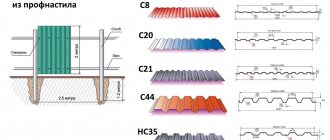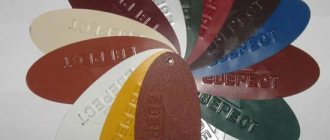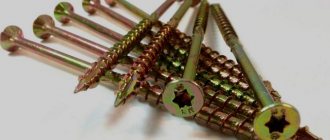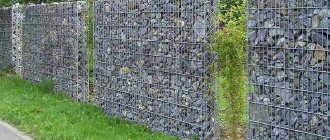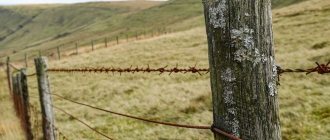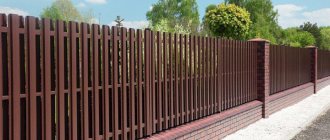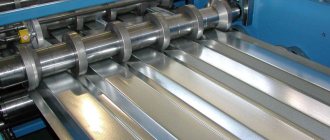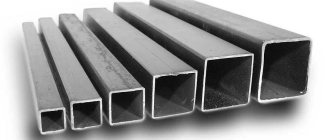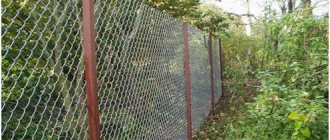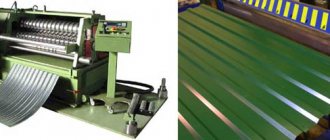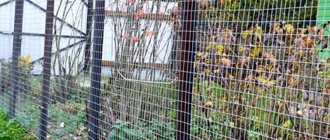Fencing made from corrugated sheets is distinguished by durability, speed of assembly, and aesthetics. Because of these advantages, it has gained popularity when arranging dachas, country houses, and private sector estates. But to install a high-quality structure, you need to be able to properly attach the corrugated sheet to the fence. This assembly stage has important points, which we will discuss in this article.
Features of fastening corrugated sheets depending on the material of the pillars
Before purchasing corrugated sheets, you should select the raw materials, type of coating, and color in advance. In addition, you need to calculate the number of sheets and fasteners for them. You will find detailed recommendations for choosing sectional material here:
- What kind of corrugated sheeting is used for fences
- Fence made of metal siding under timber
After this, you can begin construction. Having determined the location and completed the markings, they form supports for the future fence. The method of attaching the corrugated sheet depends on what material they are made of.
Brick
Creating brick pillars is a labor-intensive, long and expensive process due to the high cost of the material. But ready-made supports do not require additional finishing, and if masonry technology is followed, they will last for decades.
Article: laying pillars for a brick fence
They screw the corrugated sheet onto the fence with such posts not onto the brick, but to special metal lintels.
Tree
Inexpensive option for supports. The frame is assembled quickly, so you can easily handle it alone.
But builders do not recommend using wood as posts for a permanent fence made of corrugated sheets. Even with careful care, the fence is unlikely to last more than 5–8 years. It is better to install such racks under temporary fences.
We recommend reading the article: “Installation of wooden fence posts.”
To properly attach corrugated sheets to wooden posts, you must first fix the metal corners and then use self-tapping screws. An alternative is to immediately mount the sheets to the joists with self-tapping screws, but this option is inferior in strength to the first.
Metal
The most reliable type of supports for corrugated sheets.
The only caveat is the need to coat the poles with an anti-corrosion solution to protect the metal. For aesthetics, it is recommended to paint the support. An article about the procedure for installing metal poles.
There are two ways to attach logs to racks:
- Welding. The crossbars are welded strictly horizontally between the posts or in front of them on the street side of the fence. The frame is more rigid and stable in the first case.
- Cross-shaped brackets. They are plates with curved edges that are attached to the joists with self-tapping screws. This option does not require welding.
If you have no experience in welding, then it is better to use the second type of installation.
What screws to use to attach corrugated sheeting to a fence?
To install a fence, profiled sheets of grade C20 are most often used. Moreover, it does not matter whether it is mounted on a slope or on a flat surface. For fixation, a fastening element is used, which is called a self-tapping screw.
Drawing of one screw
This is a steel rod with a head and external thread. The self-tapping screw is capable of cutting threads into the material into which it is screwed, without the need to first make a hole.
The main difference between a self-tapping screw and screws and bolts is that the thread is located on the entire surface of the rod. The fastener has a good indicator of strength, which it receives after factory heat treatment during production.
Scheme for screwing a metal profile onto a fence
Taking into account GOST, all types of self-tapping screws are certified according to international requirements. The production material used is high-quality galvanized steel or stainless steel.
The choice of self-tapping screws that are designed for fixing corrugated sheets to the fence is large. Fasteners have different head shapes, diameters and sizes. Manufactured in diameters of 3.9–6.4 mm, sizes 18–24 mm.
Sketch of the correct screwing of self-tapping screws
Head splines can be of different shapes. The choice of tool for fastening will depend on this. Self-tapping screws can also be supplied complete with rubber washers, which has a good effect on the tightness of the connecting fasteners.
In the photo you can see different types of screws.
In one hardware store
Sheet fastening schemes
Below are diagrams of the correct installation of corrugated sheeting to metal and brick pillars, an example of installation of sheets when creating gates, wickets, photos of fastening the material when the fence is on a slope.
Basic information
Metal profile sheets are characterized by high elasticity. They have excellent strength and flexibility. This building material is made of galvanized steel, thanks to which it resists corrosion and other negative destructive external factors.
Photo - Corrugated roof
The key criterion for installing profile decking is its weight. The mass of a wall profile is slightly lighter than a roofing profile, because it is installed vertically, which means there is more stress on the fastening elements. In addition, the material used to cover the fence must be light enough to support its weight during strong gusts of wind and create the necessary tension on the frame. These sheets are used for covering gates, fences, walls, erecting interior partitions, and installing on building facades.
While the roofing sheeting is fastened purely horizontally to the sheathing and frame. There are more requirements for metal roofing profiles than for wall ones. It has a high load-bearing capacity, good rigidity and strength; despite the flexibility of steel, this material can withstand various physical shock and static loads.
Photo - Corrugated fence
Video: fastening metal profiles
We select reliable fasteners
There are several ways to fix sectional material to the fence frame:
- self-tapping screws;
- bolts and nuts;
- rivets;
- welding
Let's look at the features of each of them and determine the most reliable one.
Self-tapping screws
To secure fence sheets, roofing screws (hardware) are often used. They are made from steel type C1022, which is highly durable and has a protective anti-corrosion zinc coating 15 microns thick.
Photo: color scheme of roofing screws
They consist of 3 parts:
- Drill. Using it, the element is screwed into the corrugated sheet.
- Rubber gasket under the press washer. Located under the cap itself. Ensures the tightness of the fastener and prevents moisture from penetrating the sheets at the points of fixation.
- Heads (hats). It is covered with a durable layer of polymers, due to which the self-tapping screw becomes resistant to environmental influences. The colors are different and matched to the sectional material. This way the hats become almost invisible against the general background of the fence. Shapes – round, hexagonal, cylindrical, semicircular.
Hardware is produced with a diameter of 4–6.5 mm and a length from 19 to 250 mm.
It is most convenient to screw in the screws with a screwdriver.
Photo: the process of attaching corrugated sheets to joists using a screwdriver
To calculate the required number of elements, you need to divide the total area of the sheathed fence (including overlaps) by the area of one sheet. Builders recommend doubling the number of hardware near the ends for greater fastening strength.
The average consumption of self-tapping screws is considered to be 8–9 pieces per 1 square meter. m.
When screwed in, the fastening element must be strictly perpendicular to the sheet without distortion.
To assemble fence sections, it is allowed to use hardware for metal tiles.
Bolts
This fastening method is as strong as self-tapping screws.
Photo: securing sheets to the profile using bolts. You should first drill holes for the diameter of the bolt.
In addition, if the hardware can be easily unscrewed with a screwdriver and penetrated into the fenced estate, then the bolts can only be removed from the inside of the yard. But their price is several times higher than self-tapping screws, and the color range is limited to black and silver, which significantly sets them apart from the general sectional covering.
It will not be possible to do the fastening work using this method alone, since the sheet will have to be attached to the frame in advance, mark the hole for the bolt, drill it, and only then fix the corrugated sheet to the joists.
The average norm for 1 sheet is 4 pieces.
Rivets
Provide a strong connection between the corrugated sheet and the fence frame. Consist of two parts made of different metals:
- hats made of aluminum;
- legs made of steel.
Hats are:
- colored;
- unpainted.
Diameter – from 3.2 to 6.5 mm. Fastening is carried out using a rivet gun.
Photo: metal rivet for a manual rivet gun
The average consumption of elements is from 6 to 8 pieces per 1 sq. m.
With this method of fixation, you do not need to drill through the profile to get a strong connection; it is enough to make a hole in only one side of the joist.
When choosing rivets, it is important to consider the weight of the sectional material. The larger the diameter of the rivet, the stronger the fastener.
You also need to pay attention to the length of the purchased elements. It should be selected so that the tip of the rod is visible above the fixation site by at least 10 mm. It will not be possible to achieve this with a lower rigidity index.
How to attach profiled sheets to a wooden frame?
For roofs mounted on wooden sheathing, there is no alternative to traditional metal screws. Select screws with the largest thread pitch. The larger this parameter, the more reliable the mount.
Vertically located profiled sheets that do not require a hermetic fastening, in order to save money, are fastened with galvanized self-tapping screws with a monolithic press washer. In everyday life it is an ordinary self-tapping screw with a wide head. For screwing, a Phillips screwdriver is inserted into the screwdriver.
If the sheathing is made of DVL, chipboard, etc., we use screws with double-threaded threads. For the roof, we make a set of washers and cuffs ourselves, selecting the diameter of the screw.
We do not recommend:
- Use standard wood screws, including those intended for fastening plasterboard sheets. This fastener has a countersunk head and, when screwed in, will damage the surface of the corrugated sheet.
- Use screws with a drill tip. Wood does not require drilling, a sharp self-tapping screw is screwed in more securely, and the passage through corrugated sheets makes it acceptable for a large amount of work.
Why you shouldn't use welding
Craftsmen do not recommend installing sheets by welding due to high temperatures. Accidental thermal exposure will destroy the protective layer of corrugated sheeting and lead to further corrosion of the material, and in the absence of experience, you can completely deform the section or make a hole in it.
If the fence is needed as a temporary structure and quickly, then all welded metal elements are cleaned, treated with an anti-corrosion solution and painted.
Connection methods and installation procedure for corrugated sheets
Performed in two ways:
- Butt. Each sheet is individually attached to the fence joists. Most often, the fastening elements are self-tapping screws in the amount of 5–6 pieces per 1 sheet. Additional screws are screwed at the bottom to increase strength. Mounting holes are pre-drilled. They should be slightly larger in size than the diameter of the screw. In places where the sheets join, flashings are fixed.
- Overlapping. The most durable installation method. The amount of overlap of the corrugated sheet is one wave (profile bending). The hardware is tightened until it fits tightly to the material. As in the first case, holes for self-tapping screws are drilled in advance, after which it is recommended to treat them with an anti-corrosion compound.
It is important to note that, regardless of the chosen method, holes for hardware are drilled strictly level, adhering to a straight line. This ensures smooth fastening of the sheets to the fence frame.
In addition, it is worth considering the following points:
- To speed up the assembly process, make marks with a marker or chalk at the points where the screws will enter the sheet.
- First you need to secure the edges of the corrugated board, check the verticality and then proceed to fixing the intermediate screws.
- If the logs are wooden and the hardware rotates during installation, then it is permissible to stuff a small sliver of wood into the fastening area.
- To cut sheets, use metal scissors or a jigsaw. It is not recommended to use a grinder. Sparks during operation of the tool damage the protective coating of the material, causing the sheets to begin to corrode.
Upon completion of installation, corner joints and ends of the material can be processed. It is better to cover them with a metal strip of the same color as the fence, placing them on hardware in increments of up to 30 cm.
It is necessary to take into account
Equally important is the correct choice of rivet parts. For its successful implementation, the following conditions must be met:
- such devices must have the appropriate shape for fastening sheets to the profile;
- the diameter and length of the rivet depend on the mass and thickness of the material being fixed;
- When purchasing, you should choose models of fasteners taking into account future aesthetics (the color of fasteners should be similar to the corrugated sheet or harmoniously combine with it).
The final view of a fence made of profiled material with rivets
To save time searching for weight indicators for C8 corrugated sheets, below is a table with the most popular varieties of this model.
| No. | Thickness, mm | Weight 1 sq. m, kg |
| 1 | 0,3 | 2,46 |
| 2 | 0,35 | 2,85 |
| 3 | 0,4 | 3,24 |
| 4 | 0,45 | 3,63 |
| 5 | 0,5 | 4,03 |
| 6 | 0,55 | 4,42 |
| 7 | 0,6 | 4,81 |
It is equally important to know that rivets are made of aluminum and galvanized steel. Such products, among other things, differ in the type of collar:
- wide – designed for maximum tight fastening;
- hidden - it is necessary to attach such to create a single smooth surface, devoid of protrusions from fasteners;
- classic - used in all types of installation due to the versatility of the structure.
Possible forms of devices
When determining the length of the rivets, you should be guided by the future optimal dimensions of the protruding part. Once in place, the end of the rod should protrude exactly one cm before flaring. Your hand can also help to check the optimal distance. By measuring the length of the nail on any of the fingers, you can easily control the protruding part of the rod.
The corrugated sheeting must be secured with self-tapping screws (to metal surfaces or a wooden frame) and rivets (sheet to sheet).
To install a profiled sheet, in most cases a frame is made. The structure is made from a metal profiled pipe (square, rectangle), wooden slats, a plasterboard profile, and an ordinary corner. Sometimes they make wall cladding by mounting the sheets directly to the brick or stone.
How and with what in each specific case to fix the corrugated sheet?
Installing the top decorative strip
The finishing touch to the construction of a fence made of corrugated sheets. A special strip is attached to the upper part of the structure with self-tapping screws. The color should match the fence.
Photo: corrugated sheet fencing with a welded strip
Its main purpose is to strengthen the strength of the frame and give the fence a finished look.
Compliance with the technology for installing corrugated sheets allows you to create a reliable fence with your own hands in a short time, saving money on ordering the services of specialists.
Is it possible to attach corrugated sheeting to shell rock (limestone, brick)?
We mount the sheets directly to the wall made of stone or brick using dowels and anchors. To install, pre-drill holes in the metal. We select fastener heads with a monolithic wide washer. The shape of a plastic insert with a shimmer that serves as a seal. We make the hole in the corrugated sheet 0.5 mm larger than the diameter of the insert.
We recommend:
- For quick installation, use dowels with impact screws. They differ from traditional screws and screws in the shape of the thread. Disadvantage: if struck, the surface of the sheet can be damaged.
- Do not attach sheets to surfaces with protrusions or uneven surfaces.
